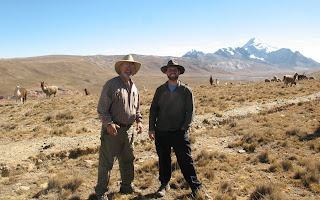The exchange rate for the Bolivian currency, Bolivianos (Bs.), hovers around Bs. 7:$1. Very often, incomes in the US and Bolivia are comparable in their respective currencies – consider the wage for a security guard at Bs. 19,200 – not far from what that job might pay in the US, but in dollars. Now put yourself in his shoes earning $19,200, or even a manager, at $30,000--here is a list of the prices you would face. Consider how your consumption might change…How often would you spend $1.50 per minute talking on your cell phone, or how would your driving habits change if you were paying over $14 for a gallon of gas. It is very interesting the pattern of prices that emerge as you shop. Those things that can be exported, or have to be imported, you pay a world price – say infrastructure and natural gas to make electricity, or Toyota Corollas. If ingredients in its production are exportable, say corn and soy for producing eggs/meat, you pay world prices for that portion, and a poor-country price for the labor. Things that are mostly labor, say daily wages for a mason or eating at a family restaurant, you pay much less.
You can see the paradox – things seem expensive to the average person, but still cheap on the world scale. So while $8.50 shoes that might last 3 years as your only shoes may seem like a bargain, Bs. 60 isn’t too easy to come by, and even after multiple repairs, we see folks working in those shoes until they’ve worn through the soles and hardly any leather keeps them attached.
We list our incomes here, but from these numbers, it’s difficult to equalize them. MCC provides us with a long list of perks that are uncommon here. They provide furniture, life insurance, a computer, motorcycles/gas, and when we’re traveling other than on vacation, MCC pays. Plus we have wonderful families back in the states (as the U.S. is called here) that gift us things out of reach of the average Bolivian. We can also buy things cheap on Ebay and have them brought down by friends—services quite unavailable in a country with undeveloped infrastructure (1 post office in each principal cities). All that to say, even though we have the goal of at least moderate voluntary poverty, we live well comparatively here in Bolivia.
| Annual Income: | Bolivianos | $ U.S. (7:1) |
| Security guard or driver | 19,200 | 2,743 |
| Teacher (national schools are only 8:30-12:30) | 21,000 | 3,000 |
| Low-level manager | 30,000 | 4,286 |
| MCC foreign worker (summed allowances for food, housing, etc., plus readjustment allowance) | 24,500 | 3,500 |
| Daily wage for a mason (semi-skilled day laborer) | 80 | 11 |
Food: | ||
| Gallon of gasoline (subsidized) | 14.21 | 2.03 |
| Whole frozen chicken (dead, feathered, and gutted) | 28.00 | 4.00 |
| Pound of sugar | 1.59 | 0.23 |
| Pound of whole wheat flour | 1.04 | 0.15 |
| Gallon of milk (processed) | 20.90 | 2.99 |
| Gallon of milk (fresh from the cow) | 11.40 | 1.63 |
| Cheapest candy in the store | 0.20 | 0.03 |
| Soup and entreé (family restaurant) | 13.00 | 1.86 |
| Clothes: | ||
| Used pants | 25.00 | 3.57 |
| Locally produced sandals (leather & tire tread) | 60.00 | 8.57 |
| Other: | ||
| City bus fare (no transfers) | 1.50 | 0.21 |
| Dentist visit for cleaning | 140.00 | 20.00 |
| Electricity per kWh | 1.00 | 0.14 |
| Cheapest cell phone | 300.00 | 42.86 |
| Cell phone call per minute | 1.50 | 0.21 |
| Used Toyota Corolla (6-10 yrs old, without title, steering wheel on the wrong side) | 31,500 | 4,500 |
| Used Ford Explorer (8 years old, with papers) | 63,000 | 9,000 |
| Social Services: | ||
| Visit to government health post in rural areas | Free | |
| Birth of a child (medical care) | Free | |
| Attending a prenatal/infant's checkup | +25 | 3.57 |
| A child completes a year of school | +200 | 28.57 |
| Senior citizen monthly social security payment | +200 | 28.57 |
Healthcare has been a government priority and it shows. Healthcare is free from birth until 21yrs for all residents (including MCC workers). If the person is in school/college, this coverage extends to 24yrs. Free healthcare is also given to the elderly after 60yrs. In the rural areas that have organized and put health as a priority, there is free basic medical care for everyone. We have an excellent “posta” in Moro Moro, and have 4 doctors for a population of ~3,500 in our municipality. I’ve never waited more than 10 minutes to see the doctor, and the pharmacy is across the hall. National taxes amount to ~15% of income if you work for a registered business, and a sales tax of 13% is charged at large businesses, and at smaller places if you ask for an official receipt, a “factura.” Being an institution, we’re in trouble if we don’t insist on factura receipts.
According the the U.S. State Dept., "The United States forgave almost all of Bolivia’s bilateral debt between 1999 and 2002." Much debt remains however from international institutions such as the International Monetary Fund and International Development Bank. Bolivia qualifies as a "Highly Indebted Poor Country", and debt, equaling 44% of GDP, much lower in real terms, and percentage terms than the U.S.
We have lived in Bolivia 6 weeks shy of a year, and daily discoveries continue in how our lifestyles differ, but our humanity is the same. The subtleties of prices, rural self-sufficiency, shape our context and how we relate to people around us.





